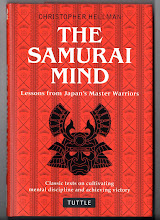 |
| Kano Tanyu's painting from Nijo Castle - a reproduction is now on display |
The beautiful paintings of the Kano school were made for patrons, many of whom were the principal warlords of the day (religious institutions and members of the Imperial family were also notable patrons) and many of these paintings formed grand decorative schemes, filling all the walls of single or multiple chambers.
In some cases, the theme was the message – tigers and birds of prey were obvious choices for military men, while flowers and birds often decorated the chambers of women of important households. Yet there was also much overlap, with many temples using the same motifs as the warlords, and the decorative schemes of castles employing multiple elements to different effect depending on the use of the room (and the type of visitors that might be expected). In fact, temples took on a number of roles and functions, and often played host to important figures when they travelled.
A good example can be seen at Nijo Castle in Kyoto. The paintings and other decorations were completed under the auspices of Kano Tanyu, the head of the Edo Kano School. He painted many of the major paintings himself, and other members of the family, and the Kyoto Kano School worked under him.
A visitor of the warrior class, on arriving at Nijo Castle, the Tokugawa shogun’s official residence in Kyoto, might be shown into a room gloriously decorated with tigers prowling through a bamboo grove, putting him in mind of the power and the potential danger represented by the shogun. If granted an audience, he would be shown into a chamber decorated with majestic pine trees in whose branches perched imperious eagles or hawks. They would have looked even more impressive in those days, as they would have been viewed from a seated position, and much of the time the visitor would be keeping his head lowered in deference to the shogun. In any case. He could not fail to identify these motifs with the powerful man before him.
 |
| Nijo Castle with reproductions of the original paintings |
An imperial envoy, on the other hand, would be granted an audience in a room decorated with flowering cherry trees, showing that the shogun was also a man of culture, worthy of the position bestowed on him (by the emperor, who really didn’t have much choice in the matter, especially after the position had become hereditary).
 |
| Aimed to impress through cultural legitimacy rather than intimidation. |
These motifs were certainly symbolic, though perhaps only in a general way. In some cases, the motifs were far more specific in the symbols they employed. An interesting example of this can be seen at Zuiganji Temple in Sendai, whose patron, the powerful warlord Date Masamune, maintained strong associations with the temple. The decorative scheme of one of its rooms, the Taka no Ma (The Hawk Room) is more direct. Serving as a waiting room for Masamune’s vassals, when he visited or was staying at the temples, it incorporates a number of motifs that illustrate sayings meant to instruct the vassals on behaviour proper to the bushi class.
Below are some of the paintings showing the parts in question with a short explanation of their message. The originals have been replaced with modern replicas (painted by experts in the copying of historical paintings – some art colleges still have this as a department), so they probably look pretty close to how they would have appeared in their prime, though losing much of the atmosphere of the faded originals.
All of these illustrate well-known sayings, and Date Masamune’s interest in this kind of thing may well have stemmed from the rigorous education he received from the monk Kosai Soitsu. Two of them are puns, while two of them are direct illustrations of sayings.
Bushi shouldn't allow themselves to be made fools of. This contains a play on the word kamo, which means both duck and to be made a fool of.
Bushi should not be involved in fraud. Similarly, this contains a play on the word sagi, which means both a heron or egret and fraud.
If the pheasant didn’t cry out, it wouldn’t get shot. In this case, the pheasant has revealed itself and a hawk is in hot pursuit. Obviously a lesson on the value of keeping quiet. Even today, the proverb, ‘the nail that sticks up will be hammered down’ is often put into practice.
If you chase two rabbits, you won’t even catch one. It’s difficult to tell if there is a second rabbit from this picture (or even a first one if you don't know what you're looking for - it's the white thing directly below the eagle). Nonetheless, the meaning is clear. Note also the similarity in pose to the hawk in the Nijo Castle painting at the top of this blog. Training in the Kano school made much use of the copying of standard models – this was an important part of maintaining standards and reproducing the school's signature style.
For comparison, here is a picture of how some of the original paintings in Zuiganji looked before they were replaced. Although I appreciate the original paintings, I must admit that the venue does make a big difference to the effect on the viewer. I haven't been to Nijo Castle for a few years, but, depending on the weather, the paintings certainly didn't always show very well. Visitors couldn't get very close, and there was a constant pressure to move on, rather than stand and look. Perhaps they are better in the attached museum where the selection on view can be examined at close quarters. However, it could also be argued that there is nothing quite like the experience of seeing art in situ as it has been for hundreds of years.















